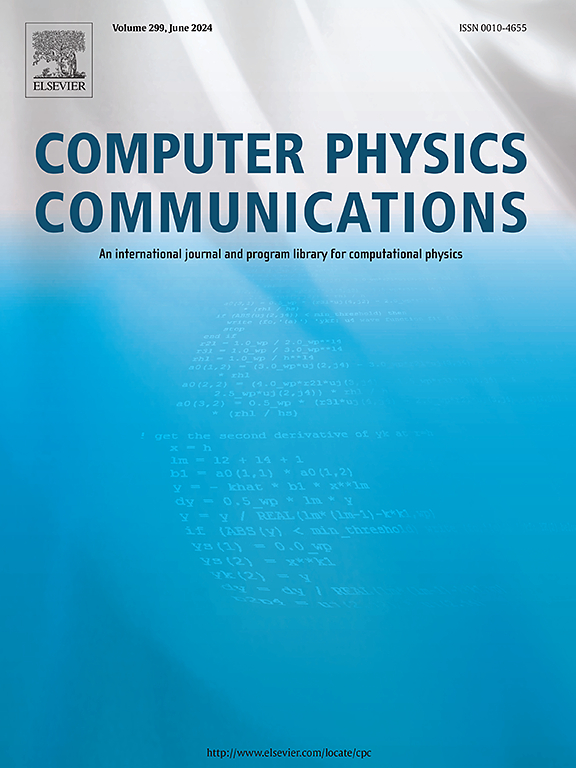基于流体模型的电容耦合等离子体快速模拟策略
IF 7.2
2区 物理与天体物理
Q1 COMPUTER SCIENCE, INTERDISCIPLINARY APPLICATIONS
引用次数: 0
摘要
在工业领域,流体模拟被广泛用于优化反应器的几何形状和提高电容耦合等离子体(CCP)源的性能,因此高计算速度非常重要。本研究基于等离子体源多物理场分析(MAPS)框架,开发了一种用于 CCP 流体模拟的快速方法,其中包括求解电子流体方程的多时间步长显式上风方案、求解泊松方程的半隐式方案和带相内初值的迭代法、求解重粒子流体方程的带有限人工扩散的显式上风方案,以及一种基于流体方程修正的加速方法,以缩短达到平衡所需的时间。为了证明新开发方法的有效性和效率,在气态电子会议(GEC)反应器的氩气放电中对 COMSOL 进行了基准测试,并与实验数据进行了比较。此外,还测试了每种加速方法的性能,结果表明多时间步长的显式欧拉方案能有效降低大体积等离子体的计算负担,并将电子流体方程的时间成本减少一半。相内初值法可以大大减少求解线性方程所需的迭代次数,并将泊松方程的计算时间降低了 77%。基于方程修正的加速方法可将达到平衡所需的时间缩短三分之二。本文章由计算机程序翻译,如有差异,请以英文原文为准。
Fast simulation strategy for capacitively-coupled plasmas based on fluid model
Fluid simulations are widely used in optimizing the reactor geometry and improving the performance of capacitively coupled plasma (CCP) sources in industry, so high computation speed is very important. In this work, a fast method for CCP fluid simulation based on the framework of Multi-physics Analysis of Plasma Sources (MAPS) is developed, which includes a multi-time-step explicit upwind scheme to solve electron fluid equations, a semi-implicit scheme and an iterative method with in-phase initial value to solve Poisson's equation, an explicit upwind scheme with limited artificial diffusion to solve heavy particle fluid equations, and an acceleration method based on fluid equation modification to reduce the periods required to reach equilibrium. In order to prove the validity and efficiency of the newly developed method, benchmarking against COMSOL and comparison with experimental data have been performed in argon discharges on the Gaseous Electronics Conference (GEC) reactor. Besides, the performance of each acceleration method is tested, and the results indicated that the multi-time-step explicit Euler scheme can effectively decline the computational burden in the bulk plasma and reduce the time cost on the electron fluid equations by half. The in-phase initial value method can greatly decrease the iteration times required to solve linear equations and lower the computational time of Poisson's equation by 77 %. The acceleration method based on equation modification can reduce the periods required to reach equilibrium by two-thirds.
求助全文
通过发布文献求助,成功后即可免费获取论文全文。
去求助
来源期刊

Computer Physics Communications
物理-计算机:跨学科应用
CiteScore
12.10
自引率
3.20%
发文量
287
审稿时长
5.3 months
期刊介绍:
The focus of CPC is on contemporary computational methods and techniques and their implementation, the effectiveness of which will normally be evidenced by the author(s) within the context of a substantive problem in physics. Within this setting CPC publishes two types of paper.
Computer Programs in Physics (CPiP)
These papers describe significant computer programs to be archived in the CPC Program Library which is held in the Mendeley Data repository. The submitted software must be covered by an approved open source licence. Papers and associated computer programs that address a problem of contemporary interest in physics that cannot be solved by current software are particularly encouraged.
Computational Physics Papers (CP)
These are research papers in, but are not limited to, the following themes across computational physics and related disciplines.
mathematical and numerical methods and algorithms;
computational models including those associated with the design, control and analysis of experiments; and
algebraic computation.
Each will normally include software implementation and performance details. The software implementation should, ideally, be available via GitHub, Zenodo or an institutional repository.In addition, research papers on the impact of advanced computer architecture and special purpose computers on computing in the physical sciences and software topics related to, and of importance in, the physical sciences may be considered.
 求助内容:
求助内容: 应助结果提醒方式:
应助结果提醒方式:


